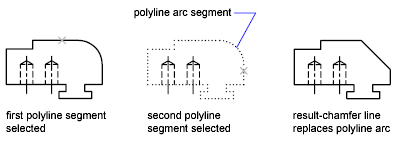A chamfer connects two objects to meet in a flattened or beveled corner.
A chamfer connects two objects with an angled line. It is usually used to represent a beveled edge on a corner.

You can chamfer
- Lines
- Polylines
- Rays
- Xlines
- 3D solids (not available in AutoCAD LT)
CHAMFER can be used to bevel all corners of a polyline using a single command.
If both objects being chamfered are on the same layer, the chamfer line is created on that layer. Otherwise, the chamfer line is created on the current layer. The layer affects object properties including color and linetype.
Use the Multiple option to chamfer more than one set of objects without leaving the command.
Chamfer by Specifying Distances
The chamfer distance is the amount each object is trimmed or extended to meet the chamfer line or to intersect the other. If both chamfer distances are 0, chamfering trims or extends the two objects until they intersect but does not create a chamfer line. You can press and hold Shift while selecting the objects to override the current chamfer distances with a value of 0.

In the following example, you set the chamfer distance to 0.5 for the first line and 0.25 for the second line. After you specify the chamfer distance, you select the two lines as shown.

Trim and Extend Chamfered Objects
By default, objects are trimmed when chamfered, but you can use the Trim option to specify that they remain untrimmed.
Chamfer by Specify Length and Angle
You can chamfer two objects by specifying where on the first selected object the chamfer line starts, and then the angle the chamfer line forms with this object.
In this example, you chamfer two lines so that the chamfer line starts 1.5 units from the intersection along the first line and forms an angle of 30 degrees with this line.

Chamfer Polylines and Polyline Segments
You can chamfer segments of a polyline that are adjacent or separated by no more than one arc segment. If they are separated by an arc segment, as shown in the illustration, chamfering deletes the arc and replaces it with a chamfer line.

You can also chamfer the endpoints of an open polyline. This operation creates a closed polyline.
Chamfer an Entire Polyline
When you chamfer an entire polyline, each intersection is chamfered. For best results, keep the first and second chamfer distances equal.
In this example, the chamfer distances are set to equal values.

When you chamfer an entire polyline, only the segments that are long enough to accommodate the chamfer distance are chamfered. The polyline in the following illustration has some segments too short to be chamfered.
